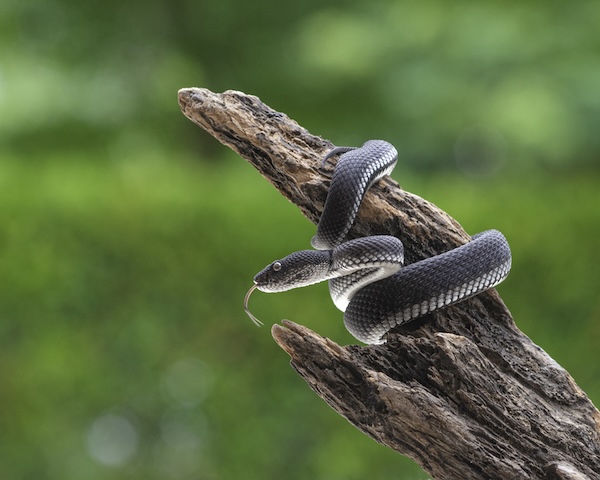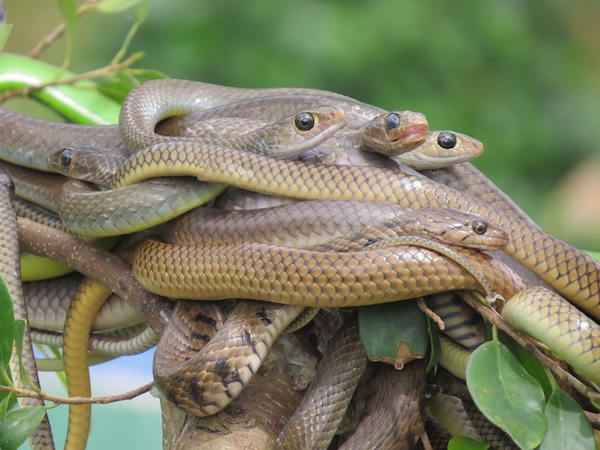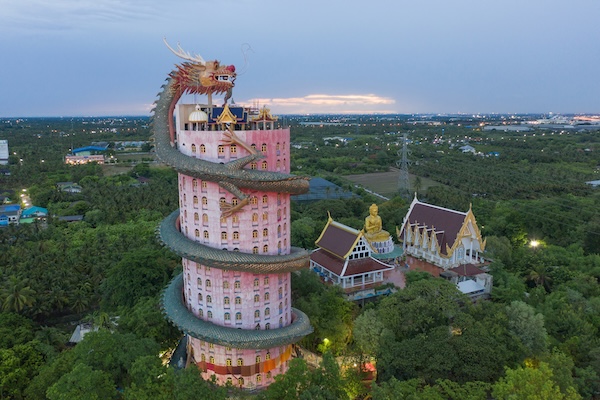Venomous Snakes in Thailand
| Species | Venom / Key Symptoms | Main Distribution |
|---|---|---|
| Monocled cobra (Naja kaouthia) | Neurotoxic – rapid respiratory paralysis | Central plains, rice fields, urban wasteland |
| King cobra (Ophiophagus hannah) | Neuro- & cardiotoxic | Dense forests North & South, national parks |
| Banded krait (Bungarus fasciatus) | “Silent” neurotoxin – mild pain, delayed distress | Low-land rural zones, rice paddies at night |
| Malayan pit viper (Calloselasma rhodostoma) | Hemotoxic – swelling, local necrosis | South & Central, rubber plantations |
| Green pit viper (Trimeresurus albolabris) | Hemotoxic – bleeding, oedema | Gardens, moist plots, riverbanks |
| Russell’s viper (Daboia russelii) | Hemotoxic + kidney failure | Dry North & Northeast |
| Coral snakes (Calliophis spp.) | Intense neurotoxin – rapid convulsions | Leaf litter, humid deciduous forests |
Cobras & Kraits

Pit Vipers
Masters of camouflage, these ambush predators lurk on ground or branches. The Malayan pit viper causes severe tissue necrosis in plantations. Green pit vipers, often perched at shoulder height, strike mostly after rain. The seldom-seen Russell’s viper brings haemorrhage and renal failure—hospital care within six hours is critical.Coral Snakes
Brightly hued speckled and blue coral snakes rarely bite humans, yet their ultra-fast neurotoxin demands assisted ventilation and a species-specific antivenom.Iconic Non-Venomous Species
Reticulated Python – Gentle Giant
World record holder for length (up to 7 m / 23 ft), the reticulated python is non-venomous and keeps rodent numbers low. Dramatic rescues sometimes occur in Bangkok’s suburbs, but attacks on humans remain extraordinary.
Noteworthy Colubrids
- Giant rat snake (Ptyas mucosa) – temple rat-catcher, up to 3 m.
- Paradise tree snake (Chrysopelea paradisi) – “flying” snake that glides 20 m between trees.
Where Are Encounters Likely?
Gardens & Urban Areas
Colubrids, green pit vipers and young pythons favour leaf piles, garages and drains. Keep yards tidy and pathways lit at night. For more Thai wildlife, see our complete guide to Thailand’s animals.Forests, National Parks & Rice Fields
Cobras, kraits, pit vipers and some arboreal boas share trails and dykes. Walks just after a shower—classic of the rainy season—increase encounters; stick to paths and wear high-cut shoes.Coasts, Mangroves & Reefs
Sea snakes haunt shallow waters, nets and coral wrecks. Fishermen wear thick gloves to avoid accidental bites.Prevention & First Aid
Smart Habits
- Closed shoes and long trousers during hikes or gardening.
- Headlamp after dark—60 % of bites occur at night.
- Never try to catch or kill snakes: 4 out of 5 bites stem from reckless handling.
If a Bite Occurs
- Stay calm; limit movement.
- Remove rings, bracelets, shoes before swelling.
- Rinse gently with clean water; no soap or alcohol.
- Sling or splint the limb at heart height.
- Reach the nearest hospital—specific antivenoms are stocked nationwide.
🩺 Travel with Peace of Mind
- The unexpected can happen quickly. A simple consultation or hospitalization in Thailand can cost thousands of dollars. Good travel insurance covers your medical expenses, repatriation, and provides assistance if problems arise. It’s the essential step for a worry-free stay.
- Exclusive Offer: By using the links in our guide, the insurance providers we recommend offer you up to a 5% instant discount on your policy.
Emergency Costs & 24-h Hospitals
An antivenom vial costs 2 000 – 5 000 THB (covered by Thai public hospitals). Major 24-hour facilities in tourist hubs include Chiang Mai Ram Hospital, Phuket Vachira, and Bangkok’s Queen Saovabha Snake Farm clinic.Emergency Numbers & Resources
- Medical Emergency (EMS) : 📞 1669 – free, nationwide
- Thai Red Cross – Queen Saovabha Snake Farm : 📞 +66 2 252 0161 (official site)
- Facebook group Snakes of Thailand ID – rapid ID by volunteer herpetologists.
Recent Statistics & Ecological Impact
Around 12 000 snake-related consultations occur annually in Thailand. Thanks to fast access to antivenom, fatalities stay below 0.1 %. One cobra eating a single rat can protect up to 2 kg of rice from rodent damage—snakes thus spare farmers pesticides and income loss.💳 Your Credit Card Insurance Won’t Be Enough.
- Insurance from credit cards (like Visa Signature, World Elite…) has low coverage limits and high deductibles, often insufficient to cover the actual costs in Thailand. A serious accident could leave you tens of thousands of dollars out of pocket.
- The Solution: Opt for a specialized insurance provider that offers multi-million dollar coverage limits, direct payment for hospital expenses without you advancing any money, and coverage for adventure activities like scooter riding or diving.
Snakes in Thai Culture

Conclusion
With these tips, sharing territory with snakes in Thailand becomes far less daunting: you can spot dangerous species, avoid risky situations and react effectively to bites while appreciating their vital ecological role.Quick FAQ
Are snakes more active during the rainy season?
Yes. Moderate heat, high humidity and plentiful prey make them easier to spot.Which snake is the most dangerous?
The banded krait tops lethality charts thanks to its lightning-fast neurotoxin.Should I carry antivenom on a trek?
No. Each species needs a specific serum, stocked in provincial hospitals.How do I identify a snake quickly?
Photograph from a safe distance and consult the Facebook group Snakes of Thailand ID or call the Snake Farm.Do pythons attack humans?
Extremely rarely; they prefer rodents, poultry and small mammals.🔄 Last updated on September 11, 2025
